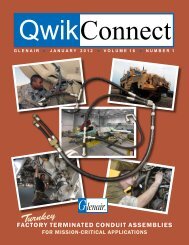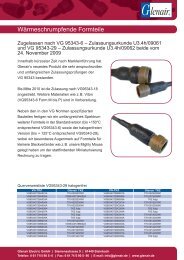July 2008 - Glenair, Inc.
July 2008 - Glenair, Inc.
July 2008 - Glenair, Inc.
Create successful ePaper yourself
Turn your PDF publications into a flip-book with our unique Google optimized e-Paper software.
Crimp-and-Poke Comes<br />
to the MIL-DTL-83513<br />
Micro-D Connector<br />
Attaching wires to contacts with solder is a<br />
standard practice in the interconnect industry.<br />
Solder termination has several advantages,<br />
including that it can be accomplished without the use<br />
of highly-specialized tools. But solder terminations<br />
are difficult to perform in the field when a connector<br />
requires modification or repair. Likewise, connectors<br />
equipped with pre-terminated wire pigtails—typically<br />
molded in place or potted at the factory with a plastic<br />
sealant—are challenging to work with in applications<br />
where field repairability and ease-of-assembly are<br />
required.<br />
For these reasons,<br />
crimp style contacts<br />
(which marry the<br />
conductor<br />
to the<br />
contact<br />
with<br />
controlled<br />
compression<br />
applied with a<br />
specialized crimp tool<br />
and die) are preferred in<br />
many military, aerospace,<br />
industrial and rail applications.<br />
Crimp contacts, which can be inserted and removed<br />
multiple times from the connector, allow for contact<br />
replacement or circuit changes with little difficulty<br />
compared to solder or mold-in-place contacts.<br />
Military standard type connectors, such as<br />
the ubiquitous D38999, utilize a four indent crimp<br />
contact termination system which affords uniform<br />
displacement of both the wire conductor and the<br />
contact material. Upon completion, the wire strands<br />
and contact material are formed together in a<br />
solid mass with a minimum of voids and little or no<br />
extrusion of the wire strands.<br />
In a well performed crimp joint, the metal flow<br />
of the malleable gold-plated copper contact and<br />
the copper wire conductor essentially form a cold<br />
2<br />
QwikConnect<br />
weld. The mechanical strength of the cold weld joint<br />
is outstanding, as is its electrical continuity. In pull<br />
tests, the wire conductor will separate long before<br />
the wire would pull away from the crimp joint.<br />
Because of the different environments in<br />
which electrical connectors are deployed, there are<br />
situations in which solder and/or pigtail assemblies<br />
are perfectly acceptable or are in fact preferred over<br />
crimp. <strong>Glenair</strong>’s MIL-DTL-83513 qualified connector<br />
series is a perfect example. In fact, this TwistPin<br />
equipped Micro-D is the preferred interconnect in<br />
missile systems and other miniaturized<br />
applications that do not require the<br />
versatility of a crimp contact system.<br />
These are<br />
typically “install<br />
and forget” applications<br />
that are not subject to<br />
repeated mating cycles or postproduction<br />
modifications.<br />
But other applications,<br />
for example modular<br />
avionic systems,<br />
are more suited<br />
to crimp contact<br />
systems. But<br />
unfortunately,<br />
there have<br />
been few good<br />
choices when it comes to rectangular,<br />
D-shaped connectors used in miniaturized rack-andpanel<br />
or module-to-chassis applications. Until Now!<br />
QwikConnect is proud to introduce a versatile<br />
new crimp-contact connector series: the Series<br />
79 Micro-Crimp from <strong>Glenair</strong> is the perfect choice<br />
for applications which require the convenience<br />
of a hybrid crimp contact system in a Micro-D<br />
Subminiature package. The following pages present<br />
a short overview of the “Micro-Crimp” including<br />
connector architecture, accessories, and layouts.<br />
For ordering information and other product details,<br />
a “sneak-peak” of the new draft catalog has been<br />
posted at www.glenair.com. The Series 79 connector<br />
is available now and ready for deployment in rugged<br />
applications that require small size and weight,<br />
environmental sealing, improved shielding and, most<br />
importantly, the convenience of industry-standard<br />
crimp-and-poke signal, power and coax contacts.<br />
QwikConnect n <strong>July</strong> <strong>2008</strong>











